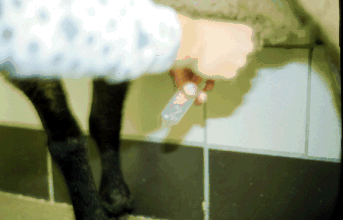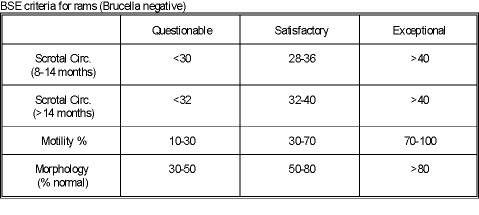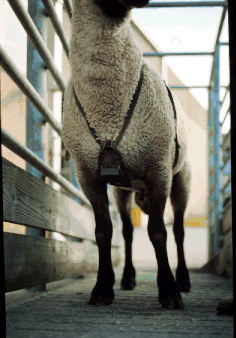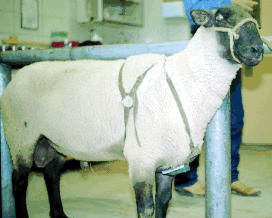Ram
Breeding Soundness Examination
 575-584 575-584
- A breeding soundness examination is recommended
for all rams immediately prior to breeding.
- The importance of this
exam cannot be stressed too highly.
- An infertility problem in the
ram can be very costly in a single-sire breeding group. (He must be
considered as half the breeding flock).
- Rams may be classified as
-
sound,
- questionable
- unsound.
- Occasionally we detect problems which are
temporary or treatable.
This examination involves:
- Body condition scoring and conformation
- Good condition but not too fat (need to feel
them)
- Feet, legs and back should be sound
- Testicular palpation and measurement
- SC correlated with:
- sperm production,
- age of
puberty in offspring
- Epididymitis may be detectable by palpation -
check carefully that scrotum is full of testes
Semen collection and evaluation
- Artificial Vagina can be used, hand held
electroejaculator is the most common.

- Rams usually all or none (good or azoospermic)
- No WBC should be seen, as they are the first
sign of B.ovis
- The effects of the Louisiana summer can damage
semen quality for up to 49 days (after last exposure to extreme
heat). It is important to take this into account in this evaluation
and also when selecting your breeding season.
- Abnormal sperm cells seen.
- < 5 WBC/High power field

Interpretation
- Unsatisfactory in any - cull
- Questionable in any - retest
- Satisfactory in all - breed 50 ewes
- Exceptional in all - breed 100 ewes
Ram
Infertility
EpididymitisBrucella
ovis #1 infertility problem
- Transmission - venereal ram to ram
- Ewe is mechanical vector
- Generally older ram flock problem
Diagnosis
-
Palpation
-
WBC
in semen
-
Complement Fixation
testing
- Culture
- Semen culture - not 100 % reliable
-
Brucellosis test - a simple inexpensive blood
test will establish if your ram has brucellosis before
you begin breeding. Cannot differentiate vaccination titers
Control recommendations
-
Cull palpably affected rams
-
Cullrams with WBC (PMN) in semen
-
Cull rams with > 30% detached heads
-
Cull all CF pos. rams (if not vaccinated)
-
Vaccination is questionable at controlling
- B. ovis + Strain 19 used
Actinobacillus seminis
-
Seen in young rams
-
Spread by sodomy
-
See: epididymitis, orchitis, pus
- Diagnosis - signs, culture
- Control - cull affected
Breeding
Management of rams
Puberty and Sperm Production
- Puberty in the male is the time at which
reproduction is first possible, that is when the testes begin to
produce sperm cells.
- This time is governed by testicular size which
in turn is a factor of the ram's body weight.
- Most rams will reach
puberty between 5 and 9 months of age depending on body weight,
nutrition, breed and various environmental factors.
- Although your
rams have reached puberty by 9 months of age they may not be
"successful" breeders until they have learnt correct
sexual behavior.
Sexual Behavior
- It is important to understand the ram's
behavioral patterns in order to correctly choose a mating percentage
(ie the ratio of rams to ewes).
- Mature ewes in heat will form harem groups
around rams.
- These groups will seek out the ram, maintain proximity
to him and overtly solicit his attention.
- Younger ewe lambs in their
first and second estrus (heat) will not form these groups.
- Thus ewe
lambs require greater confinement and a higher mating ratio than
adult ewes.
- Younger ewes are usually subordinate to adult ewes and
this reduces their chance of being mated if run with adult ewes.
* separate maiden ewes from mature ewes for
breeding
- Ewes vary in their attractiveness to rams.
- In
any group of estrus ewes, some will receive more attention than
others. In turn some ewes will compete for proximity to a ram.
- Rams
have a preference for ewes of their own breed or appearance.
- The average ewe will be bred 2-4 times in one
estrus period. Females may need to be inseminated more than once to
achieve pregnancy.
- Dominant rams will prevent submissive rams from
breeding ewes.
- If a ram with poor semen or low libido (sex-drive)
exhibits this "blocking" behavior in a multi-sire mating
group, obviously poor lambing rates will result.
- This stresses the
need for breeding soundness examination (BSE) prior
to breeding.
- Rams will form a pecking
order for sexual competition which is identical to their feeding
competition order.
- Subordinate rams will have decreased mounting and
ejaculating frequency even if the dominant ram is in an adjacent
pen.
* get a BSE on your rams before breeding
- Ram lambs reared together exhibit homosexual
behavior. As well as propagating epididymitis, this will have
temporary effects on the mating behavior of these rams when exposed
to ewes.
- * raise ram lambs singly or at least in
close proximity to ewes
Mating Ratio
- The optimum ratio of rams to ewes vary with age
of females, scrotal circumference of rams, age of rams and the size
and terrain of the mating area.
- If rams are healthy
and fertile,
and if there are no geographical restrictions, then 1 ram can breed
100 females.
- For maiden ewes this ratio should be reduced to 1:50.
-
Likewise young rams (2-tooth) may not be active as mature rams and
the ratio should be reduced.
Harnesses
- The use of a harness with a colored crayon is
now a standard technique to monitor mating patterns within a flock
during the breeding season.
- The harness should be fitted carefully
to the ram so that chafing does not occur and so that ewes are
correctly marked. Harnesses and crayons should be checked regularly.
-
The crayon color is changed every 15 days so that ewes which breed
back can be detected.
 
For example:
-
yellow ochre for day 1-15
-
venetian red 15-30
-
lamp black 30-45
- Obviously, ewes marked with more than one color
are returning to the ram.
- This technique may also be used as an
early pregnancy test.
- Some care must be taken in interpreting these
results as very light marks may go undetected and not all ewes that
are marked necessarily produce a lamb.
Heat Stress
- By far the most common cause of problems we see
in the breeding season is heat.
- Hot weather (greater than 4 days at
greater than 80 degrees) during breeding reduces libido, mounting
frequency and semen production and quality, especially in European
breeds.
- We advise:
- don't begin breeding too soon, better to have
late lambs than no lambs at all.
- if the weather remains hot, house rams and
breed only at night.
Shearing
- About 0.5 to 1 cm of wool is ideal for the
breeding flock.
- Too much wool will make your rams susceptible to
heat stress and reduce their efficiency.
- Feet trimming, if
necessary, should be performed at this time.
Nutrition
- Rams will eat less and lose condition during
the breeding season. It is important that rams begin the season in
good condition and that you maintain their condition (2-4
lbs/head/day).
|
 Male
Index
Male
Index




